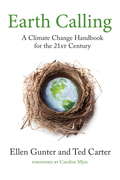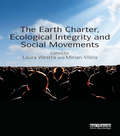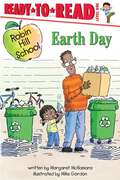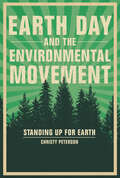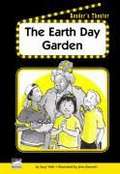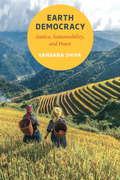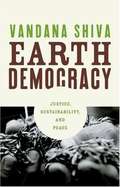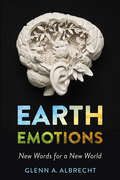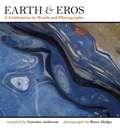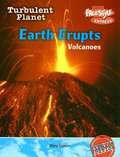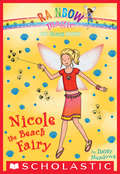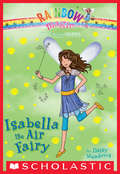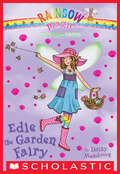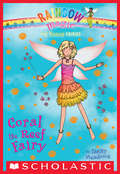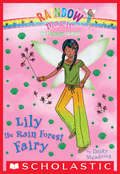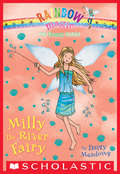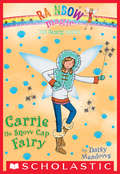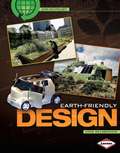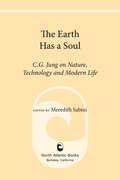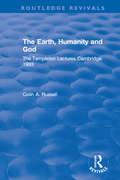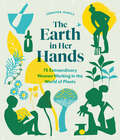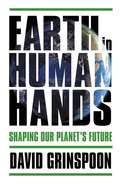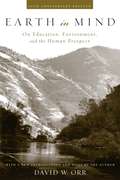- Table View
- List View
Earth Calling
by Ted Carter Caroline Myss Ellen GunterOur earliest mythologies tell us we all start as a little bit of dirt. These stories carry a profound message: each of us is born with a deep and abiding connection to the earth, one that many of us have lost touch with. The Silent Spring for today's environmental activists, this book offers an invitation to reestablish our relationship with nature to repair our damaged environment. Chapter 1 examines the threats to the planet's health through the lens of the human energy system known as the chakras, describing how the broken first chakra relates to our disconnection from our biosphere. Chapter 2 shows how our current environmental crises--global warming, climate change, dwindling water resources, natural disasters such as wildfires and hurricanes--represent severe manifestations of our disconnection from the earth.Chapter 3 describes how the preponderance of oil in our culture--especially agribusiness--compounds this disconnection, from our dependence on other countries for our energy, to current issues of oil depletion, peak oil, and fracking, to the dumbing down of our agricultural polyculture.Chapter 4 explains how the most basic building blocks of our nourishment--seeds--are being compromised with a loss of biodiversity and rise of GMOs, and how that adversely affects the farmers whose sacred connection to the land has in many cases been severed. Chapter 5 describes the ways in which we as individuals can begin to wake up to climate activism as a spiritual practice. This chapter includes specific activities that you can use to implement change and heal your own connection to the earth. By learning and practicing ritual and understanding the earth's rhythms and seasonal rites of passage, each of us can find unique ways to heal our own connections and help others heal theirs. Chapter 6 brings to life Goethe's wisdom: "Knowing isn't enough; neither is being willing. We must do," by providing strategies and resources for exploring how each of us can find our own Earth Calling, then anchoring that calling with the only force that ignites change: Action.From the Trade Paperback edition.
The Earth Charter, Ecological Integrity and Social Movements
by Laura Westra Mirian VilelaThe Earth Charter is a declaration of fundamental ethical principles for building a just, sustainable and peaceful global society, with ecological integrity as a major theme. This book provides a series of analyses of ecological integrity as it relates to the Earth Charter, social movements and international law for human rights. It is shown how the Earth Charter project began as a United Nations initiative, but it was carried forward and completed by a global civil society initiative. The drafting of the Earth Charter involved the most inclusive and participatory process of its time ever associated with the creation of an international declaration. This process is the primary source of its legitimacy as a guiding ethical framework. The Earth Charter was finalized and then launched in 2000 and its legitimacy has been further enhanced by its endorsement by over 6,500 organizations, including many governments and international organizations. In the light of this legitimacy, an increasing number of international lawyers recognize that the Earth Charter is acquiring the status of a soft law document. The book also shows the strong connection between ecological integrity and social justice, particularly in the defence of indigenous people, and includes contributions from both the North and the global South, specifically from Central and South America.
Earth Day: Ready-to-Read Level 1 (Robin Hill School)
by Margaret McNamaraIn the latest beginning reader from the bestselling, classroom based Robin Hill School series the class celebrates Earth Day! <p><p> The kids in Mrs. Connor's class are celebrating Earth Day, and everyone has lots of ideas on how to save the Earth...except Emma. Emma is worried that her ideas are not good enough. With the help of her dad and Mrs. Connor, Emma learns that her small ideas can have big results!
Earth Day and the Environmental Movement: Standing Up for Earth
by Christy PetersonOn April 22, 1970, an estimated twenty million people held in a teach-in to show their support for environmental protections. This new celebration, Earth Day, brought together previously fragmented issues under the same banner. It was the largest nationwide event ever, and lawmakers took notice. But one day didn't change everything. Fifty years after the first Earth Day, climate change remains a dire concern. The divide between political parties continues to widen, and environmental policy has become an increasingly partisan issue. The spread of disinformation has also made climate change a debatable idea, rather than scientific fact. A new generation of advocates continue the fight to make environmental policy a top priority for the United States and for nations around the globe. "Our goal is an environment of decency, quality, and mutual respect for all human beings and all other living creatures . . . Our goal is a decent environment in its broadest, deepest sense."—Gaylord Nelson, Earth Day founder "[T]he potential consequences are certainly major in their impact on mankind. Now is the time. The research is clear. It is up to us now to summon the political will."—Robert Walker, US Representative from Pennsylvania "There's always a perception that business and industry and conservation groups . . . don't agree on anything. . . . [W]e can come together to demonstrate that we might be looking at it from different sides, but the outcome is the same."—Doug Miell, consultant, Georgia Chamber of Commerce
The Earth Day Garden
by Suzy Wall Jeffrey Fuerst John BennettPerform this script about people who work together to turn an empty lot into a garden.
Earth Democracy
by Vandana ShivaWorld-renowned environmental activist and physicist Vandana Shiva calls for a radical shift in the values that govern democracies, condemning the role that unrestricted capitalism has played in the destruction of environments and livelihoods. She explores the issues she helped bring to international attention--genetic food engineering, culture theft, and natural resource privatization--uncovering their links to the rising tide of fundamentalism, violence against women, and planetary death. Struggles on the streets of Seattle and Cancun and in homes and farms across the world have yielded a set of principles based on inclusion, nonviolence, reclaiming the commons, and freely sharing the earth's resources. These ideals, which Dr. Shiva calls "Earth Democracy," serve as an urgent call to peace and as the basis for a just and sustainable future.From the Trade Paperback edition.
Earth Democracy: Justice, Sustainability, and Peace
by Vandana ShivaBoldly confronting the neoconservative Project for the New American Century, world-renowned physicist and activist Vandana Shiva responds withEarth Democracy, or, as she prophetically names it, "The People's Project for a New Planetary Millennium. " A leading voice in the struggle for global justice and sustainability, here Shiva describes what earth democracy could look like, outlining the bedrock principles for building living economies, living cultures and living democracies. Starting from the initial enclosure of the commons--the privatization of six million acres of public land in eighteenth-century Britain--Shiva goes on to reveal how the commons continue to shrink as more and more natural resources are patented and fenced. Accompanying this displacement from formerly accessible territory, she argues, is a growing attitude of disposability that erodes our natural resources, ecological sustainability and cultural diversity. Worse, human beings are by no means safe from this assignment of disposability. Through the forces of neoliberal globalization, economic and social exclusion work in deadly synergy to perpetrate violence on vulnerable groups, extinguishing the lives of millions. Yet these brutal extinctions are not the only trend shaping human history. Forthright and energetic, Vandana Shiva updates readers on the movements, issues and struggles she helped bring to international attention--the genetic engineering of food, the theft of culture and the privatization of natural resources--and deftly analyzes the successes and new challenges the global resistance now faces. From struggles on the streets of Seattle and Cancun and in homes and farms across the world has grown a set of principles based on inclusion, nonviolence, reclaiming the commons and freely sharing the earth's resources. These ideals, which Shiva calls "earth democracy," will serve as unifying points in our current movements, an urgent call to peace and the basis for a just and sustainable future.
Earth Education: A New Beginning
by Steve Van MatreEarth education aims to accomplish what environmental education set out to do, but didn't: to help people improve upon their cognitive and affective relationship with the earth's natural communities and life support systems, and begin crafting lifestyles that will lessen their impact upon those places and processes on behalf of all the earth's passengers. If you care about the health of our troubled planet, then you should read what this internationally known educator has to say about how we lost a whole generation of teachers and leaders and what you can do to help them find their way again.
Earth Emotions: New Words for a New World
by Glenn A. AlbrechtAs climate change and development pressures overwhelm the environment, our emotional relationships with Earth are also in crisis. Pessimism and distress are overwhelming people the world over. In this maelstrom of emotion, solastalgia, the homesickness you have when you are still at home, has become, writes Glenn A. Albrecht, one of the defining emotions of the twenty-first century.Earth Emotions examines our positive and negative Earth emotions. It explains the author's concept of solastalgia and other well-known eco-emotions such as biophilia and topophilia. Albrecht introduces us to the many new words needed to describe the full range of our emotional responses to the emergent state of the world. We need this creation of a hopeful vocabulary of positive emotions, argues Albrecht, so that we can extract ourselves out of environmental desolation and reignite our millennia-old biophilia—love of life—for our home planet. To do so, he proposes a dramatic change from the current human-dominated Anthropocene era to one that will be founded, materially, ethically, politically, and spiritually on the revolution in thinking being delivered by contemporary symbiotic science. Albrecht names this period the Symbiocene.With the current and coming generations, "Generation Symbiocene," Albrecht sees reason for optimism. The battle between the forces of destruction and the forces of creation will be won by Generation Symbiocene, and Earth Emotions presents an ethical and emotional odyssey for that victory.
Earth & Eros
by Bruce Hodge Robert Michael Pyle Lorraine AndersonIn the tradition of The Sense of Wonder by Rachel Carson and On the Loose by Terry and Renny Russell, Earth & Eros combines words and photographs to inspire readers to deepen their connection with the good Earth. The book awakens readers to the full force of eros - life force that connects us to our bodies, other humans, all living beings, and the Earth as a living being.Intended as an antidote to an age obsessed by speed, screens, and machines, this book brings together previously published prose and poetry with 25 fine art landscape photographs to explore the sacred erotic dimension of humans' relationship to the Earth.The writings in Earth & Eros were chosen for their brevity, readability, beauty, and potency, and the photographs for their sensuality. Readers engage with writers such as David James Duncan, Hart Crane, Diane Ackerman, Sherman Alexie, D. H. Lawrence, Mary Oliver, and Pablo Neruda. Some of the pieces of writing are explicitly sexual, while others appreciate the sensuality of tree limbs, seeping water, mushrooms, and ferns. Earth and Eros is beautifully produced and a pleasure to hold and to look at, a book to read and reread slowly, out loud.
Earth Erupts: Volcanoes (Turbulent Planet)
by Mary ColsonThis book explains what happens when a volcano violently explodes. Find out why volcanoes form and how to survive when the Earth Erupts.
The Earth Fairies #1: Nicole the Beach Fairy (The Earth Fairies #1)
by Daisy MeadowsThe fairies are going green!<P> The fairy king and queen have just put together a new team of seven fairies for a very special mission. They are the Earth Fairies! Together, they're going to work their magic to clean up the environment. But they can't do it alone. Luckily, Rachel and Kirsty are ready to help!<P> The beach on Rainspell Island is covered with garbage, and it's putting the sea creatures in danger. But Nicole the Beach Fairy can't do much without her missing magic wand. Can the girls help her track it down?<P> Find the missing magic wand in each book and help save the environment!
The Earth Fairies #2: Isabella the Air Fairy (The Earth Fairies #2)
by Daisy MeadowsThe fairies are going green!<P> The fairy king and queen have just put together a new team of seven fairies for a very special mission. They are the Earth Fairies! Together, they're going to work their magic to clean up the environment. But they can't do it alone. Luckily, Rachel and Kirsty are ready to help!<P> The air on Rainspell Island is thick with smog. Isabella the Air Fairy wants to return the island's fresh ocean breezes and sparkling blue skies. But she can't do anything without her wand!<P> Find the missing magic wand in each book and help save the environment!
The Earth Fairies #3: Edie the Garden Fairy (The Earth Fairies #3)
by Daisy MeadowsThe fairies are going green!<P> The fairy king and queen have just put together a new team of seven fairies for a very special mission. They are the Earth Fairies! Together, they're going to work their magic to clean up the environment. But they can't do it alone. Luckily, Rachel and Kirsty are ready to help!<P> Rachel and Kirsty are volunteering for a gardening project. They're going to turn an unused lot into a beautiful garden. But first they need to find Edie's missing wand-before it's too late!<P> Find the missing magic wand in each book and help save the environment!
The Earth Fairies #4: Coral the Reef Fairy (The Earth Fairies #4)
by Daisy MeadowsThe fairies are going green!<P> The fairy king and queen have just put together a new team of seven fairies for a very special mission. They are the Earth Fairies! Together, they're going to work their magic to clean up the environment. But they can't do it alone. Luckily, Rachel and Kirsty are ready to help!<P> Coral the Reef Fairy's magic keeps the reef environment healthy. But Jack Frost's goblins have her wand and underwater environments everywhere are in trouble. Can Rachel and Kirsty find the wand and put an end to Jack Frost's plans? <P> Find the missing magic wand in each book and help save the environment!
The Earth Fairies #5: Lily the Rain Forest Fairy (The Earth Fairies #5)
by Daisy MeadowsThe fairies are going green!<P> The fairy king and queen have just put together a new team of seven fairies for a very special mission. They are the Earth Fairies! Together, they're going to work their magic to clean up the environment. But they can't do it alone. Luckily, Rachel and Kirsty are ready to help!<P> Lily the Rainforest Fairy whisks the girls away to a tropical forest to find her wand. Lily needs her wand to save the rainforest-and to get Rachel and Kirsty home safe again.<P> Find the missing magic wand in each book and help save the environment!
The Earth Fairies #6: Milly the River Fairy (The Earth Fairies #6)
by Daisy MeadowsThe fairies are going green!<P> The fairy king and queen have just put together a new team of seven fairies for a very special mission. They are the Earth Fairies! Together, they're going to work their magic to clean up the environment. But they can't do it alone. Luckily, Rachel and Kirsty are ready to help!<P> Rachel and Kirsty are helping Milly the River Fairy clean up a polluted river. But troublemaking goblins keep getting in the way. The girls need to get Milly's wand back to make the river a safe place again.<P> Find the missing magic wand in each book and help save the environment!
The Earth Fairies #7: Carrie the Snow Cap Fairy (The Earth Fairies #7)
by Daisy MeadowsThe fairies are going green!<P> The fairy king and queen have just put together a new team of seven fairies for a very special mission. They are the Earth Fairies! Together, they're going to work their magic to clean up the environment. But they can't do it alone. Luckily, Rachel and Kirsty are ready to help!<P> Rainspell Island's weather is wacky-and it's all because Carrie the Snow Cap Fairy's magic wand is missing. Her magic helps keep the earth's climate under control. Rachel and Kirsty are determined to outsmart Jack Frost and keep the earth clean and green! <P> Find the missing magic wand in each book and help save the environment!
Earth-Friendly Design (Saving Our Living Earth)
by Anne WelsbacherDesigners create all products, from computers and cell phones to cars and buildings, to meet the needs and desires of buyers. But did you realize that each stage in the life of a manufactured product involves processes that can damage Earth's land, air, water, and the health of living things? Earth-friendly design can help us make our planet healthier. We must join together in this quest to make, move, use, reuse, and dispose of things in Earth-friendly ways. With engaging text and eye-catching images, plus a special Going Green section, this book tells you all about Earth-friendly design and what you can do to promote it.
The Earth Has a Soul: C. G. Jung on Nature, Technology and Modern Life
by C. G. Jung Meredith SabiniWhile never losing sight of the rational, cultured mind, Jung speaks for the natural mind, source of the evolutionary experience and accumulated wisdom of our species. Through his own example, Jung shows how healing our own living connection with Nature contributes to the whole.
Earth Hour: A Lights-Out Event for Our Planet
by Nanette HeffernanClick flashlights, light lanterns, and get ready to turn electric lights out to celebrate Earth Hour! Wherever you are, you can help our planet.Kids around the world use electric energy to do all kinds of things--adults do, too! From cleaning the clothes we play in, to lighting up our dinner tables, to keeping us warm and toasty when the weather is cold, electricity is a huge part of our lives. Unfortunately, it can also have a big impact on our planet.Earth Hour--a worldwide movement in support of energy conservation and sustainability--takes place each March and is sponsored by the World Wildlife Fund for Nature (WWF). During Earth Hour, individuals, communities, and businesses in more than 7,000 cities turn off nonessential electric lights for one hour. Across each continent--from the Eiffel Tower to the Great Wall of China to the Statue of Liberty--one small act reminds all of us of our enormous impact on planet Earth.
The Earth, Humanity and God: The Templeton Lectures Cambridge, 1993 (Routledge Revivals)
by Colin A. RussellOriginally published in 1994, The Earth, Humanity and God discusses the relationship between science and religion. The book discusses the condition of the earth (as it was at the time of publication) and the future prospects of the planet, arguing that neither the conventional "mechanistic" view nor "New Age" philosophy helps alone in evaluating our relationship with the Earth. The book examines methods of combatting the threats to the Earth exploring both a scientific and non-scientific stance, investigating the uncontrolled expansion of technology as well as empirical pre-scientific mysticism. The book also explores the resurgence in ancient ideas of "Mother Earth" as a dangerous piece of romantic irrationality and suggests, that these views pose a danger to religious/scientific examinations. The book suggests instead a hard-headed attempt to relate Biblical and scientific data, and that this in turn can yield a valuable new understanding of the problems facing the world.
The Earth in Her Hands: 75 Extraordinary Women Working in the World of Plants
by Jennifer Jewell&“An informative and celebratory resource.&” —Booklist In this beautiful and empowering book, Jennifer Jewell—host of public radio&’s award-winning program and podcast Cultivating Place—introduces 75 inspiring women. Working in wide-reaching fields that include botany, floral design, landscape architecture, farming, herbalism, and food justice, these influencers are creating change from the ground up. Profiled women include flower farmer Erin Benzakein; codirector of Soul Fire Farm Leah Penniman; plantswoman Flora Grubb; edible and cultural landscape designer Leslie Bennett; Caribbean-American writer and gardener Jamaica Kincaid; soil scientist Elaine Ingham; landscape designer Ariella Chezar; floral designer Amy Merrick, and many more. Rich with personal stories and insights, Jewell&’s portraits reveal a devotion that transcends age, locale, and background, reminding us of the profound role of green growing things in our world—and our lives.
Earth in Human Hands: Shaping Our Planet's Future
by David GrinspoonFor the first time in Earth's history, our planet is experiencing a confluence of rapidly accelerating changes prompted by one species: humans. Climate change is only the most visible of the modifications we've made--up until this point, inadvertently--to the planet. And our current behavior threatens not only our own future but that of countless other creatures. By comparing Earth's story to those of other planets, astrobiologist David Grinspoon shows what a strange and novel development it is for a species to evolve to build machines, and ultimately, global societies with world-shaping influence. Without minimizing the challenges of the next century, Grinspoon suggests that our present moment is not only one of peril, but also great potential, especially when viewed from a 10,000-year perspective. Our species has surmounted the threat of extinction before, thanks to our innate ingenuity and ability to adapt, and there's every reason to believe we can do so again. Our challenge now is to awaken to our role as a force of planetary change, and to grow into this task. We must become graceful planetary engineers, conscious shapers of our environment and caretakers of Earth's biosphere. This is a perspective that begs us to ask not just what future do we want to avoid, but what do we seek to build? What kind of world do we want? Are humans the worst thing or the best thing to ever happen to our planet? Today we stand at a pivotal juncture, and the answer will depend on the choices we make.
Earth in Mind: On Education, Environment, and the Human Prospect
by David W. OrrIn Earth in Mind, noted environmental educator David W. Orr focuses not on problems in education, but on the problem of education.Much of what has gone wrong with the world, he argues, is the result of inadequate and misdirected education that: alienates us from life in the name of human domination; causes students to worry about how to make a living before they know who they are; overemphasizes success and careers; separates feeling from intellect and the practical from the theoretical; deadens the sense of wonder for the created world.The crisis we face, Orr explains, is one of mind, perception, and values. It is, first and foremost, an educational challenge.The author begins by establishing the grounds for a debate about education and knowledge. He describes the problems of education from an ecological perspective, and challenges the "terrible simplifiers" who wish to substitute numbers for values. He follows with a presentation of principles for re-creating education in the broadest way possible, discussing topics such as biophilia, the disciplinary structure of knowledge, the architecture of educational buildings, and the idea of ecological intelligence. Orr concludes by presenting concrete proposals for reorganizing the curriculum to draw out our affinity for life.
